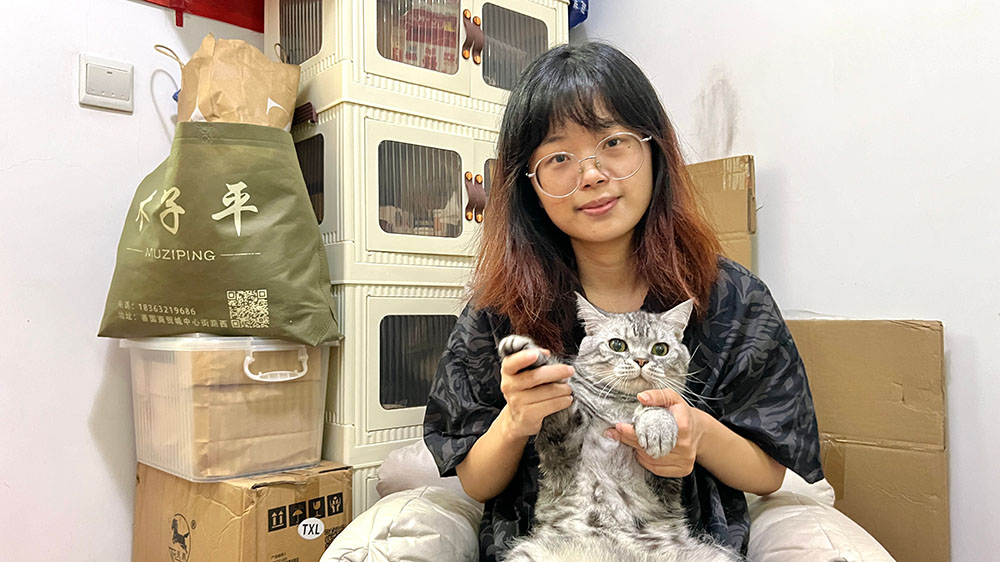At a recent pet expo in Wuhan, an expensive intelligent cat litter box sparked heated debate. While some praised its cutting-edge technology, others questioned whether such luxury spending is justifiable in a country with vast wealth inequality. What do these lavish pet products reveal about China’s changing attitudes towards consumption?

27-year-old local resident Ms. Guo Luman was the centre of attention at the Wuhan Pet Expo on July 13th when she immediately placed an order for a sleek, futuristic product. “My cat deserves the best,” she said with a proud smile, clearly pleased with her purchase.
What is this product? It’s a smart litter box priced at 6,500 RMB (around £698), equipped with automatic cleaning, odour control, and even a built-in monitoring system that tracks the pet’s health.
Clearly, this is about more than just a product—it reflects deeper societal tensions around wealth, consumption, and inequality.
As the expo continued, voices of dissent began to emerge among the crowd. “Is it really necessary to spend so much on a cat litter box?” one onlooker asked loudly. Others began to reflect on China’s growing wealth disparity, questioning whether such spending can be justified.
China’s rapid economic growth has given rise to a flourishing middle class, eager to display their newfound wealth. From luxury pet products to lavish pet funerals, the trend of conspicuous consumption has permeated nearly every aspect of life.
Yet, as more pet owners spend significant amounts on their pets, debates around the ethics of such spending are intensifying. In a country where wealth inequality remains severe, is it morally acceptable to spend thousands on pet accessories?

Sociologist Dr Zhou Mingtao explains, “This phenomenon highlights the tension between wealth and social responsibility in China. The rise of luxury pet products and services reflects a shift in consumer culture, where personal gratification and displays of social status are often prioritised over collective well-being.”
Many are asking: in a country with such a wide wealth gap, is spending so much on pets ethical, or does this point to a deeper cultural issue?

In Beijing, 31-year-old Du Wenyi runs a boutique selling luxury pet accessories. “Our best-selling products are designer pet beds and custom collars. Many customers spend over 3,000 RMB (about £322) on a single item,” she proudly states. Her clientele, typically young professionals or affluent retirees, view their pets as extensions of their own success. “They want their pets to have the best, and they don’t hesitate to spend money to show it.”
But not everyone shares this mindset. At the Wuhan Pet Expo, 60-year-old Mr Huang, a retired factory worker, attended out of curiosity. “I just can’t understand it,” he says. “I grew up in a time when it was hard enough to take care of ourselves, let alone pets. Now people are spending more on a cat litter box than some people’s monthly salary.”
Mr Huang’s sentiments echo broader criticism of China’s wealth inequality. According to a 2022 World Bank report, China’s Gini coefficient—a measure of income inequality—remains high among major economies. As the rich get richer and the wealth gap widens, this phenomenon stirs anxiety among those left behind by China’s economic miracle.

Dr Zhou argues that luxury pet spending is part of China’s modern culture of conspicuous consumption. “As people become wealthier, they want to show off their success. For many, spending on high-end pet products is a way to flaunt their social status and taste,” he explains. “But this kind of consumption also underscores the growing individualism in Chinese society, where personal fulfilment often comes before community welfare.”
This individualism, combined with the pressure to keep up with social expectations, is driving demand for luxury pet products. Guo admits that part of her motivation for buying the smart litter box came from a sense of competition. “I’ve seen so many people showing off their pet gadgets on social media. I didn’t want to feel left behind,” she confesses. Her comment reveals the role that social media plays in fuelling consumerism, where influencers and online trends encourage people to buy the latest and greatest products for their pets.
But this growing consumer culture has not gone unnoticed. At the same Wuhan Pet Expo, there were also representatives from pet charities and animal welfare volunteers. Yang Zhiwen, a 32-year-old volunteer with a Wuhan-based pet charity, expressed her concerns: “While we understand the affection people have for their pets, we have to question whether all this spending truly benefits the animals. Are pets really happier with fancy clothes, or are we just projecting our desires onto them?”
For shop owners like Du Wenyi, however, the conversation around luxury pet products goes beyond ethics. “I think it’s about the freedom of choice,” she says. “If someone has worked hard and earned money, why shouldn’t they spend it on what makes them happy? Whether it’s cars, handbags, or cat litter boxes—that’s their decision.”
But the moral questions remain. As China continues to grapple with wealth inequality, what does the rise of luxury pet consumption reveal about shifting attitudes toward consumption and social responsibility?
In a country with significant wealth disparities, conspicuous consumption has become the norm, and the rise of luxury pet products is both a symptom and a symbol of this issue. As more people are willing to splurge on their pets, the conversation about what constitutes ethical consumption and what crosses into luxury has only just begun.
As the expo winds down and the crowd disperses, Mr Huang lingers by the stand displaying the smart litter box. “I still don’t get it,” he says, shaking his head. “But I guess that’s just how things are now. If something makes people feel good, they’ll pay for it.”
